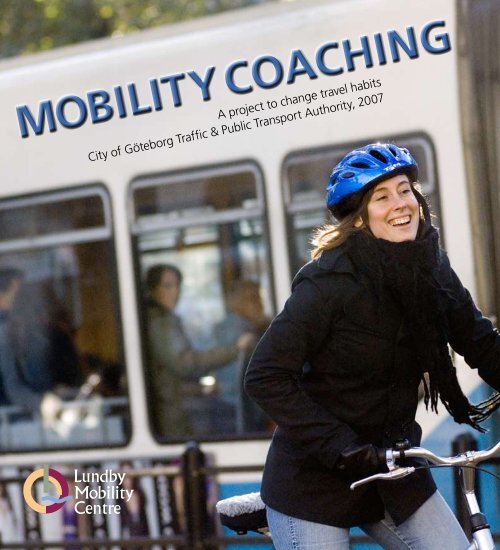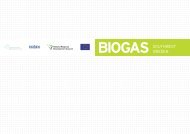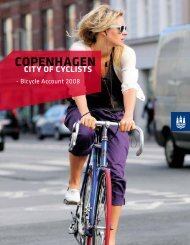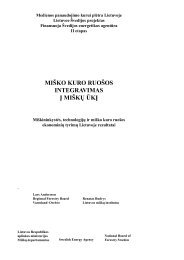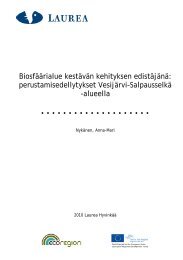mobility coaching - Lundby Mobility Centre - Göteborg
mobility coaching - Lundby Mobility Centre - Göteborg
mobility coaching - Lundby Mobility Centre - Göteborg
You also want an ePaper? Increase the reach of your titles
YUMPU automatically turns print PDFs into web optimized ePapers that Google loves.
<strong>mobility</strong> <strong>coaching</strong>A project to change travel habitsCity of <strong>Göteborg</strong> Traffic & Public Transport Authority, 2007
Participants undertook to leave the car behind and to walk, cycle or takepublic transport at least three times a week.
IntroductionIn April 2006, motorists in <strong>Lundby</strong> were giventhe chance to take part in a new travel coachproject. The innovative aspect of the project wasthat the goal was to change behaviour ratherthan just changing attitudes to travel. The targetgroup for the project comprised motoristswho used their car 5–7 days a week, i.e. peoplewho basically used no other means of transportthan their car. Participants were assistedby a coach to set their own goals and keep theirmotivation up.68 people participated actively in theproject, which ran between August 2006 andFebruary 2007. Participants signed an agreementwith the Traffic & Public Transport Authority/<strong>Lundby</strong><strong>Mobility</strong> <strong>Centre</strong> whereby theyundertook to leave the car behind and to walk,cycle or take public transport at least three timesa week. In turn <strong>Lundby</strong> <strong>Mobility</strong> <strong>Centre</strong> agreedto support and encourage the participants tohelp ensure they managed to fulfil their side ofthe agreement. In addition to the coach, two coordinatorswere available day-to-day for practicalissues and to encourage and challenge theparticipants.20 people were coached individually. Theystarted the project with a private talk to thecoach and their co-ordinator. 45 people met ingroup sessions also involving a coach and coordinator.The participants divided themselvesinto three sub-groups based on what type ofpeople they considered themselves to be:• Challenge me• Put pressure on me• Lazy/comfortableParticipants tested their fitness, weight andmuscle mass at the start and end of the project,and kept a travel diary to clarify their travelbehaviour. They were offered lectures on diet,movement and personal motivation, as well ashelp in finding public transport routes and gettingaround to visiting the cycle repair shop.The project is part of <strong>Lundby</strong> <strong>Mobility</strong> <strong>Centre</strong>’sEU project BUSTRIP. The project involves 12European cities in countries around the BalticSea.EvaluationThe project has been evaluated both throughsurveys and through interviews in order to assessvarious effects. Participants completed aquestionnaire survey both before and after theproject to enable comparisons to be made. Personalinterviews were carried out with some ofthe participants, as well as the people responsiblefor the project, the organisers (a coach, a coordinatorand the project manager). Participantsalso underwent two health checks before andafter the project to assess whether the projecthad led to changes in health. The main resultsfrom this evaluation are presented here.Aim of the project:To change behaviour.3
Reasons for getting involved in the project4Most of the participants joined the project becausethey were curious about it, needed helpgetting started exercising more, and becausethey had become too dependent on the car.Many could see the connection between sittingstill in a car and poor fitness levels. Theyneeded someone to help them move aroundmore. Many were very interested in starting tocycle, or cycling more.If this project was successful it would bepositive for the environment as car travel woulddecrease. Even so, one participant did not thinkthe environmental aspect was particularly centralto the project, suggesting that in futureprojects of this kind the environmental factorcould be pursued further. The coach in thisproject, on the other hand, did not think thatthe reason for taking part was the most importantconsideration, but primarily the goal,which was to reduce dependency on the car.“I did it for my health. I wanted a form ofeveryday exercise as I don’t have time to goand exercise in the evening. Since the childrencame along time is more of a factor.I cycle to work every day. In fact thekids cycle more now as well.”Man, 38“I was planning to start cycling but theproject gave me the chance to get somehelp. I didn’t want to contribute to apoorer environment. It was also nice notto have to exercise in the evening, I’d alreadydone it when I got home from work.”Woman, 52“I joined with a friend. The most appealingaspect in the beginning was the fitnesstests, getting a check-up. Then itwas more about the environment.”Man, 45
Group meetings – getting together for change6The organisers wereperceived as being verydedicated.Most of the participants felt that the numberof group meetings was about right. The majorityof participants interviewed thought the divisioninto groups was important and effective.Everyone agreed that there had been a positiveatmosphere in the groups. The structure workedvery well.Despite this, there were requests for moretravel activities (primarily cycling) early on inthe project, and for the organisers to join thecycle rides as well. This is worth following upon, as participants would then feel that the leaderswere not just ‘theorists’ but can actually putthemselves in their situation when they are outtravelling without the car. The process of helpingparticipants find the ‘best’ routes to andfrom work by cycle and public transport couldbe developed. This would increase credibility forthe project as well as the sense of communitywithin the group, particularly with the organisers,which ought to boost the end results. Atthe same time though this work would have tobe weighed up against costs, but certain individualmeasures are worth focusing on.Some participants also requested more groupactivities, although this does not have to meanthey are necessary if participants are to succeedwith their set goals in a project like this.Participants felt that the organisers werevery dedicated, which they also thought theyhad been themselves. This probably had a positiveeffect on the results. The three have devoteda lot of time to the project, which has been good,although this is not sustainable moving forwardif the same type of project is to be conducted ona larger scale without an increased budget.“I’d like to have seen moreactivities than we hadduring the project. Evenso, I am glad the project’sover. Now I can run onmy own steam!”Woman, 52
The project components – combined into a unityThe lectures and the health checks were particularlyappreciated by almost all the participantsinterviewed. These aspects should be retainedin some form in a future project.Half of the interviewed participants thoughtthe travel diary was a good idea and even an incentive,as it was a reminder that they were takingpart in the project. This falls in well with thetravel diary as part of the <strong>coaching</strong>, accordingto the project’s coach.The agreement signed at the beginning ofthe project, agreeing to leave the car behind forat least three days a week, had no great significancefor most of the participants interviewed.Some said it did fulfil a certain role and explainedin terms of ‘it made it harder to dropout’ and ‘it made you think before signing’.The organisers agree that no individual aspectalone was decisive, but all the project’s componentstaken together as a whole.Project components:• The <strong>coaching</strong>• The agreement• The travel diary• The lectures• The health check• The test-travel card7“I’ve fulfilled the contract I signed.I may have cut corners more withoutit so it certainly gave you somethingto think about. When I first receivedit I thought, ‘What have I got myselfinto?’, but the time passed quickly.It was all fun and exciting.”Woman, 35“I knew I wasn’t in the best shape, but the physicaltest was a wake-up call to how serious thesituation was. That stopped me from taking iteasy during the project. Without the project Ithink it would’ve taken a few more years to getstarted, if at all, and I think I’d have alreadybeen ill by then.”Man, 42
Change is possible8The number ofparticipants who drive towork every day decreasedfrom 25 to 2.62%27%An evaluation of the participants’ travel habitsafter the travel coach project reveals that cardrivinghas decreased significantly. Instead participantslike to cycle or walk, or take publictransport. The effects have been less expenditureon fuel and lower emissions.The number of participants who drive to workevery day has decreased from 25 to 2. The numberof people who cycle or walk to work at least twodays a week has increased from 18 to 49.Both the people coached individually andthose coached in groups have reduced their cardrivingdramatically. Some have reduced thenumber of owned cars in the household (6 outof 45 participants), and several said this was adirect result of the project (4 participants).All the participants believe they will continuewith their new travel habits. The projectmust therefore be viewed as very successful inthe present situation. However, the definitiveresults will be discernible after a longer period,when it will become clear whether or not theestablished new habits last in the long run.11 %20%16%26%9%26%“It was quite an aha experience when Irealised you could change your travel habits.It was easier than I thought. It was goodto meet others facing the same challenge.When the cycling got tough I had the otherproject members in my mind and could seethem struggling as well.”Woman, 52“I have a new kind of insight after talking tothe others and the coaches. The biggestthing is that I now think twice before justjumping into the car when I’m going somewhere.”Man, 45“I’m less dependent on the car and feel a bitfreer.”Woman, 52“We were given plenty of information andadvice which helped when the going gottough. I did the best I could. You want tofeel proud when you go to the meetings.I think these habits will last, even thoughthere are bound to be times when I’llstruggle.”Woman, 35Before AfterCARBefore AfterPUBLICTRANSPORTBefore AfterCYCLEBefore AfterWALKBefore AfterMCPercentage of journeys to and from work by various means beforeand after the project.
Health and environmental effects“I now get daily exercise and I’ve lost weightquite easily. I now ‘evangelise’ a bit and tryto get others at work to cycle.”Man, 38“I wanted to stop being dependent on the car.I was driving unnecessarily and was a littlebit too lazy. I wanted to move around morebut also start using public transport. Thefitness test showed a clear improvementand I feel much more energetic.”Man, 42“The good thing is my fitness has improved.I started taking new routes to work, bothwalking and on the bus, so I’ve got to seenew parts of town where I’d never beenbefore.”Woman, 35”Cycling has given me a new habit; listeningto talking books on CD. Sometimes I take alonger route so I can listen a bit more. Andnow I have a new challenge: to get to workon inlines instead of by bike.”Man, 38According to the health checks, some individualshave improved their health considerablywith better oxygen absorption and weight loss.However, for the group as a whole the healthchecks reveal no distinct changes between thestart and end of the project. One reason is probablythat the before-check was carried out inAugust-September, while the after-check wasin March-April. Both checks should have beenconducted in the same month with at least a yearin-between to avoid seasonal variations.The interviews also revealed other positive effectswhich also influence well-being, but whichthe participants had not foreseen.The participants’ contribution to negativeenvironmental effects has decreased considerablynow that their travel habits have changed. Theaverage emission of nitrogen oxides per person onwork-related trips decreased to one-third, whilethe average emission of carbon dioxide virtuallyhalved. The project has therefore contributed toa better environment, especially as those witholder cars in particular have left the car behind.64 kgHalf of the participantsfeel their healthimproved during theproject, while half feeltheir health isunchanged. Only onefeel their health hasdeteriorated.90.15 kg36 kg0.05 kgBefore AfterNITROGEN DIOXIDEBefore AfterCARBON DIOXIDEParticipants’ average emissions of nitrogen dioxide and carbondioxide for travel to and from work in kg per month and per person.
The ambassado effect10Several of the people in theproject have become socommitted that they evenevangelise to othersaround them.The project has received a lot of attention bothin the media and at the participants’ workplaces.Several of the participants mentioned the attentionthey have received at their workplace. Thiswas partly because some of them had featuredin the media, such as the newspaper <strong>Göteborg</strong>s-Posten and on the regional TV news programmeVästnytt. Participants also received attentionwhen they walked or cycled to work.There were many questions regarding travelroutes, but also about the project, and participantssaw themselves as ambassadors. Several colleagueshave also started, which meant a pleasantsubject of conversation during break times.In fact these people had become so committedthat they even evangelised to others aroundthem. Some saw themselves as ambassadors fortheir new lifestyle/travel habits. This positivespin-off effect of the project is hard to quantifybut should not be underestimated from a localperspective, be it <strong>Lundby</strong> as a city district or anindividual workplace. One of the participantshad a similar thought:This idea of concentrating a project on aworkplace should be developed further, somethingthe project leaders also had some ideasabout for the future.“The project brought attention at work and a lotof people asked about cycling, especially afterI’d been on TV. I was particularly proud whensomeone called me a role-model.”Woman, 52“I’ve talked to a lot of people about the project,especially work colleagues, and I think I’ve hadan influence on them. Half of them havestarted walking or cycling to work rather thantaking the car.” Woman, 52“I’m tremendously pleased, and more peopleought to have a chance to be involved in aproject like this. This may even be a way ofgetting whole workplaces moving.”Woman, 35
LessonsThe aim of the project was to reduce cardrivingand the target group were inveteratemotorists. Although the coach thinksthat many of the participants got involvedfor reasons of health and exercise with afocus on cycling, he believes that a key tosucceeding with a similar project is to beopen to people’s reasons for taking part.In a similar project in the future, the focusfor achieving the same goals should be established.Before the project begins, themarketing of the project should be closelyanalysed in order to achieve the greatestpossible impact and participation.The participants’ first impressionis important. The coach suggested thatone possible improvement might be tohave the ‘team line-up’ finalised whenthe participants first meet the organisers,so that co-operation partners suchas the local cycle dealer are involved andintroduce themselves. The co-ordinatorthinks it may be important to produceprofessional material for the participantsat the first meeting to show how importantthe project is. The advantage of theproject being a pilot project was that therewas more of a sense of community. Theright image should be considered beforea project begins.Because the project was a trial, it wasflexible in its approach. Nevertheless, theactivity schedule was established veryearly on so that participants could planahead. However, in a future project theentire planning process should be moreformalised to save work time, accordingto the project manager.The project’s strong point was thededication shown primarily by the participantsbut also by the organisers. Thefact that the participants felt involvedin forming the project meant that notmany people dropped out along the way,believes the coach. The project managerput forward the idea that perhaps participantsought to be let go of faster, becauseif they are not motivated enough to takepart actively their travel habits may notlast long beyond the end of the projectin any case.The <strong>coaching</strong> is based on the factthat people work differently. The coachthinks the best part of the project wasthe way participants in the individualisedgroup were taken care of and thatthey formed strong relationships. It isimportant to consider whether to startoff with interviews like in the individualisedgroup, which the coach thoughtwas important for building relationshipsin the initial stages, and if so to budgetfor this work input. The project managerthinks that a personal discussion witheach participant at the very start shouldbe considered: it may be more resourcedemandinginitially but could profit theproject overall. The co-ordinator thinksthey should have placed higher demandson the participants. However, it is importantthat the demands that are placedare consistent and clearly defined for allparticipants.The lectures were very much appreciated.One of the lectures was co-ordinatedwith other interested parties outside of theproject to cover the costs, which was anadvantage. This solution may also be appliedin future projects.The first physical test acted as a motivatorfor the participants but several didnot turn up for the final test, which couldbe because they expected a negative result.This could be avoided if the secondtest instead takes place after a year to ensurethe results are not misleading due toseasonal variations, which was also theorganisers’ experience.In summary, the now completedproject can be considered a great success.There is always room for improvement,but there is no doubting that several participantsnow have a better quality oflife while their environmental impacthas also decreased.Results and lessons have been documentedin more detail in Swedish in theTraffic & Public Transport Authority’sbulletin no. 6:2007 on the travel coachproject in <strong>Lundby</strong>.11
Between August 2006 and February 2007, 68 people in <strong>Lundby</strong>,<strong>Göteborg</strong>, took place in a travel coach project. The aim was toleave the car behind and to walk, cycle or take public transportat least three times a week. Following the project, the numberof participants who drove to work every day had decreased from25 to 2. The number of people who cycled or walked to work atleast two days a week increased from 18 to 49. All the participantsbelieve they will continue with their new travel habits.The participants’ contribution to negative environmental effectshas decreased considerably now that their travel habitshave changed. The average emission of nitrogen oxides perperson on work-related trips decreased to one-third, whilethe average emission of carbon dioxide virtually halved.The project and project evaluation have been documentedin Swedish in the Traffic & Public Transport Authority’s bulletinno. 6:2007 on the travel coach project in <strong>Lundby</strong>.SWECO VBB. PRODUCTION APPELLERA/L BULUKIN. PHOTOGRAPHY STINA OLSSON, SERGIO JOSELOVSKY. GÖTEBORG 2007For further information, please contactCity of <strong>Göteborg</strong>Traffic & Public Transport AuthorityBox 2403, SE-403 16 <strong>Göteborg</strong>, SwedenTel: +46 (0)31 61 10 00E-mail: trafikkontoret@trafikkontoret.goteborg.se


